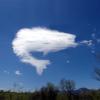In general, most of the time, the bass I know prefer to be out of sight. When they are shallow, they seem to prefer to be only as shallow as beyond where you can see bottom. They can be hard to see. They are also much relaxed under overcast skies. They appear to hunt more efficiently (although I've read otherwise in some cases -Florida in particular), but what I've seen makes me think bass may have an advantage over prey (at least sunfish) under darker conditions. Bass appreciate shade, not for temperature (it's not likely to be much different) but for security and maybe hunting advantages.
When do I see bass under bright sun? Early in the spring, on really good heating days (calm, bright sun) in shallow sheltered areas (coves are great) I may see them sunning. They are very spooky, hard to approach, quick to vacate, much less get a lure to.
Later, nearer the spawn, on good heating days, I see females holding high in the water, very near the surface, almost always near some vertical cover piece. These fish are less apt to "vacate" they just sink into the depths or swim slowly away. I've also seen them like this post-spawn into summer, and again in early fall (I believe). These fish are very willing to feed, but can be spooky under the bright conditions.
I see this in the shallow ponds I fish. There aren't deep populations of bass, and so my bass become shoreline oriented very soon after ice-out. In larger deeper water bodies many bass are known to remain deeper, although in some large natural lakes I've fished in the past, some bass do move into shallow sheltered coves, like I now see in my ponds.
These days are not always the best fishing because under bright sun in shallow water and calm conditions it is very tough not to spook them.
I can understand why you might not be catching bass on sunny days -it's difficult not to spook them. With what I have to work with here on your situation I can only guess:
One big difference between spring and summer is the amount and density of vegetation. In spring, before the weeds have grown up, bass are much more exposed.
Bass are often deeper in summer, which may explain something.
Spring waters can be very clear, before summer plankton blooms develop. High water clarity and bright sun can be really tough.
In general, I tend to have more difficulty catching shallow bass in bright sun any time of year, except very early spring and late fall, when sun angle is so low (and, at least in early spring, waters are more turbid due to water density supporting fine particles in suspension). Dense cover, deeper water, and plankton blooms, all help in summer. Most of the time, I'll take overcast conditions for sheer intensity of action almost any time.
What kind of lake type are you fishing?
How do you fish those lures in summer versus spring?
What's different between seasons in your water?
Just curious... Are you in northern WI? What are your water temps in summer? 78-80 tops? What month do your bass spawn?


